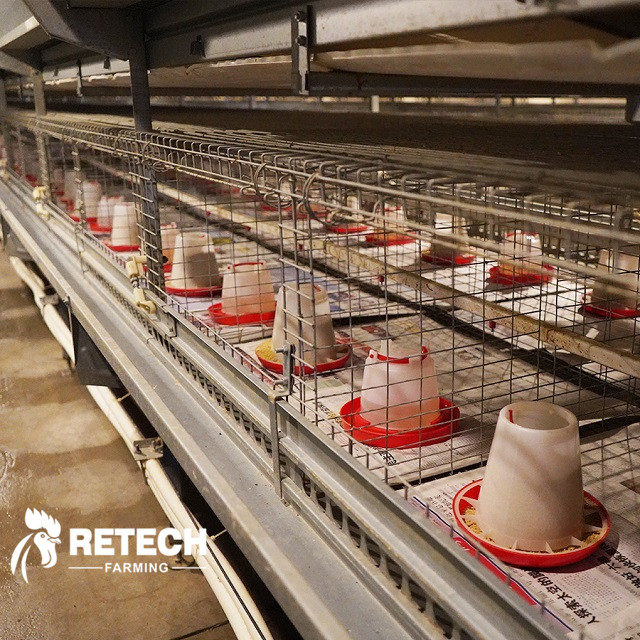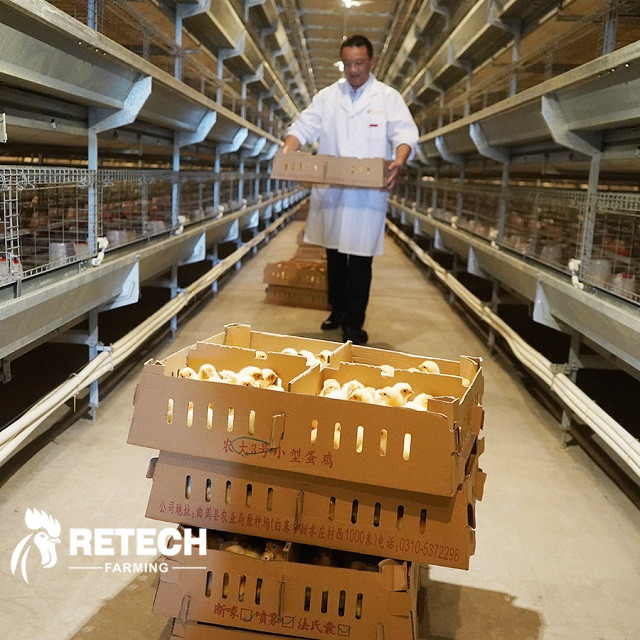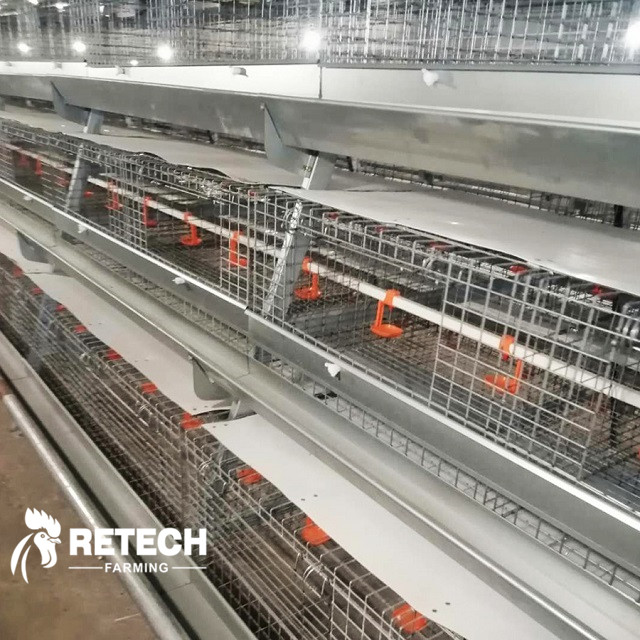Ponašanje je važan izraz sve prirodne evolucije. Ponašanje jednodnevnih pilića treba provjeravati svakih nekoliko sati, ne samo tokom dana, već i noću: ako je jato ravnomjerno raspoređeno u svim dijelovima objekta, postavke temperature i ventilacije ispravno funkcioniraju; Pilići se okupljaju u nekom području, kreću se polako i izgledaju omamljeno, što ukazuje na to da je temperatura preniska; Pilići uvijek izbjegavaju prolazak kroz neko područje, što ukazuje na to da ima vjetra; Pilići rašire krila i leže na zemlji, izgledajući kao da dahću i cvrkuću. Zvuk ukazuje na to da je temperatura previsoka ili da je koncentracija ugljičnog dioksida previsoka.
1. Niska temperatura pokupi piliće
Nakon dugog transportnog putovanja, pilići su gladni, žedni i slabi. Kako bismo omogućili pilićima da se brzo prilagode novom okruženju i vrate u svoje normalno fiziološko stanje, možemo malo sniziti temperaturu na osnovu temperature legla kako bismo održali temperaturu u leglu između 27 i 29°C, te se tako pilići mogli postepeno prilagoditi. Novo okruženje postavlja temelje za normalan rast u budućnosti.
Nakon što pilići stignu nakuća za mrljenje, potrebno im je da se prilagode novom okruženju. U ovom trenutku je normalno da se pilići odmaraju, ali nakon 4 do 6 sati, pilići bi se trebali početi širiti po kućici i početi piti vodu, jesti hranu i slobodno se kretati. Nakon 24 sata ravnomjerno ih rasporedite po kokošinjacu.
2. Odgovarajuća temperatura za inkubaciju
Ako su pilići i dalje grupirani zajedno 24 sata nakon što susmješten, to može biti zato što je temperatura u objektu preniska. Kada je temperatura u objektu preniska, ako se prostirka i temperatura zraka ne zagrijavaju, to će dovesti do slabog rasta pilića i loše ujednačenosti jata. Grupiranje pilića može uzrokovati prekomjernu toplinu, a piliće treba raširiti čim stignu u objekt za ležanje, uz održavanje odgovarajuće temperature i prigušivanje svjetla.
Da li je temperatura odgovarajuća ne može se procijeniti na osnovu vlastite udobnosti uzgajivača, niti se to može odnositi samo na termometar, već treba pratiti performanse pojedinačnih pilića. Kada je temperatura odgovarajuća, pilići su ravnomjerno raspoređeni u prostoriji za ležanje, živahnog duha, dobrog apetita i umjerene količine vode za piće.
Kada je temperatura odgovarajuća, kokoši su ravnomjerno raspoređene, a hrana je uredno raspoređena. Neke leže ili se kreću, a horizontalni tip je također ugodniji; ako je temperatura visoka, kokoši se skrivaju na rubu ograde, ali horizontalni tip je također bolji, što samo znači da je temperatura malo pristrasna. Viša temperatura, jata se mogu prilagoditi, ali žele se kloniti izvora topline. Ako je temperatura viša, kokoši više neće mirno ležati, već će disati na usta i imati spuštena krila.
3. Osigurajte odgovarajuću relativnu vlažnost
Nakon što pilići uđu ukuća za mrljenje, potrebno je održavati odgovarajuću relativnu vlažnost, najmanje 55%. U hladnoj sezoni, kada je potrebno zagrijavanje frontalnog polonija, po potrebi možete ugraditi mlaznicu za grijanje ili posipati malo vode po prolazu, efekat je bolji.
4. Ventilacija
Klima unutrauzgajalištezavisi od kombinacije suhe ventilacije, grijanja i hlađenja. Izbor ventilacionog sistema također treba prilagoditi vanjskim uvjetima. Bez obzira je li ventilacijski sistem jednostavan ili složen, prvo mora biti sposoban za manipulaciju od strane ljudi. Čak i u potpuno automatskom ventilacijskom sistemu, osjećaj očiju, ušiju, nosa i kože menadžera je važna referenca.
Prirodna ventilacija ne koristi ventilatore za podsticanje kretanja vazduha. Svjež vazduh ulazi u kuću kroz otvorene otvore za vazduh, kao što su podesivi ventili za dovod vazduha, roletne. Prirodna ventilacija je jednostavna i jeftina metoda ventilacije.
Čak i u područjima gdje je prirodna ventilacija dobra, farmeri se sve više odlučuju za mehaničku ventilaciju. Iako su investicija u opremu i operativni troškovi veći, mehanička ventilacija može pružiti bolju kontrolu okoline unutar objekta i dovesti do boljih rezultata hranjenja. Pomoću ventilacije s negativnim pritiskom, zrak se uvlači u objekt kroz ulaz za zrak, a zatim se istiskuje iz objekta. Učinkovitost mehaničke ventilacije ovisi o kontroli ulaza za zrak. Ako postoje otvoreni otvori u bočnim zidovima objekta, to će utjecati na rad ventilacijskog sistema.
Procijenite efekat ventilacije tokom vremena. Kod sistema prizemlja, raspored jata u objektu može ukazivati na efekat i kvalitet ventilacije, a efekat ventilacije se može procijeniti i drugim metodama. Jednostavan način da se to uradi jeste da stanete goli i mokri s rukama, stanete u prostor s malim brojem pilića, osjetite da li u prostoru ima propuha i osjetite da li je prostirka prehladna. Posmatrajte raspored jata u cijelom objektu za pileće kokoši i utvrdite da li je to povezano s podešavanjem ventilatora, svjetla i dovoda zraka. Nakon što su podešavanja osvjetljenja, dovoda zraka itd. promijenjena, ponovo provjerite nakon nekoliko sati da li se raspored jata promijenio. Nemojte donositi negativne zaključke o efektima promjene podešavanja. Također zabilježite sadržaj promijenjenih podešavanja.
Podešavanje brzine ventilacije ne zavisi samo od temperature, već i od vlažnosti u objektu, kao i od brzine vjetra na visini zadnjeg dijela i koncentracije ugljičnog dioksida u zraku. Kokoši će postati letargične ako je nivo ugljičnog dioksida previsok. Ako imate glavobolju nakon rada na visini zadnjeg dijela duže od 5 minuta, koncentracija ugljičnog dioksida je najmanje 3 500 mg/m3, što ukazuje na nedovoljnu ventilaciju.
Vrijeme objave: 13. april 2022.










